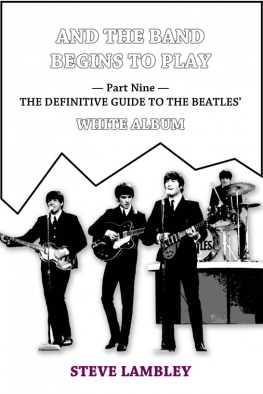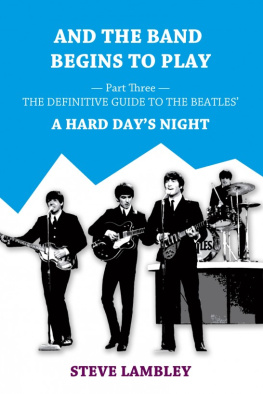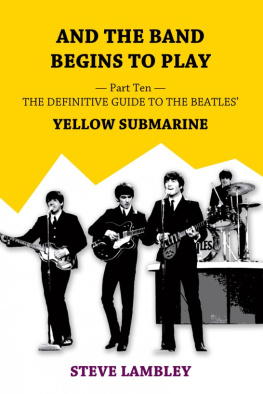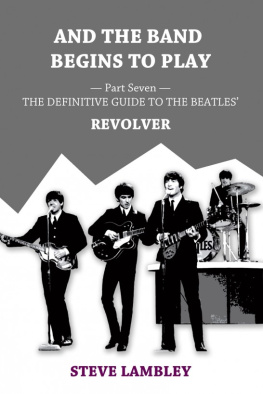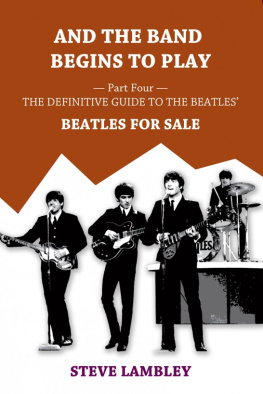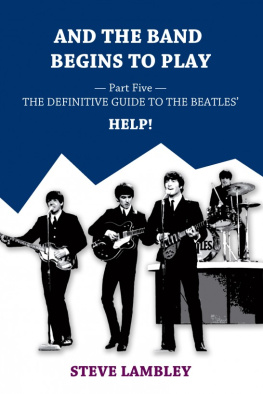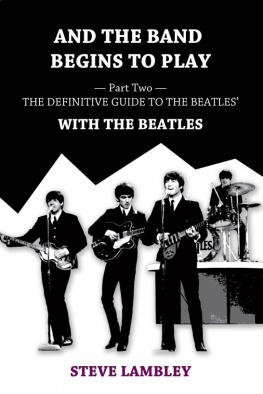AND THE BANDBEGINS TO PLAY
Part Six The Definitive Guide to the Beatles RUBBER SOUL
by
SteveLambley
Published bySLIDE Books
Version 2.0
Steve Lambley2015
All song lyricsremain the copyright of their respective owners, and are quoted forthe purposes of scholarship, under fair dealing and fair usagelaws. No infringement is intended.
No part of thisbook may be reproduced in any form without written permission fromthe copyright holder.
SmashwordsEdition, Licence Notes
This ebook islicensed for your personal enjoyment only. This ebook may not bere-sold or given away to other people. If you would like to sharethis book with another person, please purchase an additional copyfor each recipient. If youre reading this book and did notpurchase it, or it was not purchased for your use only, then pleasereturn to Smashwords.com and purchase your own copy. Thank you forrespecting the hard work of this author.
Table ofContents
Rubber Soul LP
Parlophone PMC 1267/PCS 3075 Released 3 December 1965
This was thedeparture record.
As ever, Ringosums up the situation with commendable economy. Rubber Souldoes indeed mark a watershed in the recordings of the Beatles,albeit the beginnings of a watershed, if such a thing exists.Girl, the last track to be recorded for the album, was the 100threcording, out of some 208, that the group released. For the lasttime, the Beatles released two albums of new material in a year. Atthis half-way stage we can get a good idea of the broad sweep ofthe groups output, of how things have developed, and where theyare heading.
If we think inpure Beatle terms, and forget for a moment the exceptional qualityof the output, weve had a couple of albums that have broadlydocumented the groups live sound, followed by an album of originalcompositions that showed the range of their influences. These earlyrecordings were almost exclusively love songs of one form oranother, and even in rejection were largely upbeat. The followingtwo albums began to explore darker emotions, and a moreexperimental, less mainstream musical side. Nevertheless,statements of personal failure and outright cries for help werecouched in upbeat musical settings. With Rubber Soul, whilethe songs did not show a quantum leap in terms of subject matter,composition or recording techniques, things were definitelybeginning to accelerate. Although there are clearly areas ofoverlap between Rubber Soul and Help!, there are alsoclear points of departure. So while Run For Your Life could havebeen on the previous album, and in fact Wait nearly was, andalthough What Goes On sounds rather like a Carl Perkins cover,its hard to imagine Norwegian Wood, Nowhere Man or In MyLife being recorded even six months earlier.
And again,thinking in pure Beatle terms, the extraordinary quality of thisphase of recording is evidenced by the fact that no less than halfof the 16 songs released by the Beatles in December 1965 wouldfeature on the 19621966 Red album.
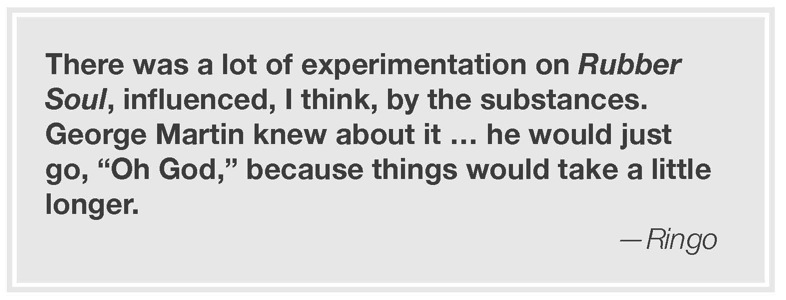
The RubberSoul LP was, for the first time, recorded without thedistraction of concert or radio appearances to disrupt therecording schedule. The songs were completed during 15 sessionsthat took place over the period of exactly one month. In fact,during this time the group had only two other commitments torecord the 50-minute TV special TheMusic Of Lennon &McCartney and to nip round to Buckingham Palace to collecttheir MBEs. (A former RAF squadron-leader, Mr Paul Pearson, hasposted his MBE back to the Queen as a protest against The Beatlesand Ena Sharples getting awards in the Birthday Honours List The Times, 15 June 1965.)
This meant thatalthough most tracks on the album were completed in a singlesession, there was continuity to the recording of the album as awhole. And it seems that the composition and recording processesproceeded in parallel, with John and Paul writing new material inthe days between recording sessions. At any rate, in September, onthe plane back from the US tour, Paul had commented, We havenothing up our sleeves at the moment, the cupboard is definitelybare.
The albumstitle comes from Pauls corruption of the term plastic soul. Hedread a comment by an unnamed blues player on Mick Jaggers music:Well you know theyre good but its plastic soul. Paul himselfrepeated the phrase after completing the first take of Im Downback in June, as can be heard on Anthology 2. The phrase hasechoed through the years, including David Bowies comment on hisown Young Americans LP: the definitive plastic soul record.Its the squashed remains of ethnic music as it survives in the ageof Muzak rock, written and sung by a white limey.
RubberSoul had its run at the top of the UK charts amid almost a yearof domination by the combined might of the Beatles and The SoundOf Music. Three ten-week spells at number one by the JulieAndrews soundtrack album were interspersed with nine-week runs,first by Help! and then by Rubber Soul. (Bizarrely,while The Sound Of Music spent a total of 70 weeks at numberone in the UK album charts and in fact was replaced at number oneby Help!, Rubber Soul, Revolver and finally(four times!) by Sgt Pepper it managed a mere fortnightatop the US charts.)
The US versionof Rubber Soul was of course rather different to theofficial Parlophone version. Capitol had a couple of tracks leftover from their dismemberment of the Help! LP. They usedthese to replace the first track on each side of the album, andremoved an additional track from each side, otherwise maintainingthe running order of the UK release. So side one kicked off withIve Just Seen A Face and omitted Nowhere Man, and side twoopened with Its Only Love and left out Georges If I NeededSomeone. For the first time since the debut Meet TheBeatles!, Capitols eighth release treated their customers to agenerous twelve tracks instead of the customary eleven (or, in thecase of Help!, seven).
As withHelp!, George Martin was unhappy with the stereo mix ofRubber Soul produced by EMI in 1987 for the CD release, andcreated a new stereo mix. This later mix was used for the 2009stereo reissues, although the Help! and Rubber SoulCDs in TheBeatles In Mono box set each included theoriginal 1965 stereo mix.
The album coverwas the fifth and last Robert Freeman creation. Freeman wanted analmost monochrome look, and found the right location for the shotin Johns Kenwood garden (although the groups driver, AlfBicknell, remembers it being taken in woods near Hatchford End, afew miles away). In the event, Freeman claims he was unable toreproduce the monochrome effect due to budgetary restrictions,although the predominantly green/brown hue comes close to hisvision.
The distortedimage wasnt planned, however, and was the result of a happyaccident. He was demonstrating the choice of shots to the group,projecting them onto an LP-sized square of card. At one point, thecard tilted slightly, producing an elongated image. The group leaptat idea of using the distortion, and the cover was made from animage produced by titling the enlarger to create the print.
For the firsttime, the groups name does not appear on the front sleeve. Thelettering was created by a little-known then as now artdirector called Charles Front. His idea was to replicate rubberproduced at source: If you tap into a rubber tree then you get asort of globule, so I started thinking of creating a shape thatrepresented that, starting narrow and filling out.
Next page
![Lambley And the Band Begins to Play: [Part6 The Definitive Guide to the Beatles Rubber Soul]](/uploads/posts/book/213742/thumbs/lambley-and-the-band-begins-to-play-part6-the.jpg)
![Lambley - And the Band Begins to Play: [Part9 The Definitive Guide to the Beatles White Album]](/uploads/posts/book/213743/thumbs/lambley-and-the-band-begins-to-play-part9-the.jpg)
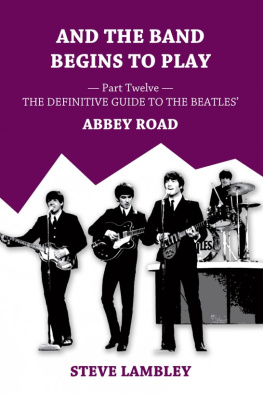
![Lambley - And the Band Begins to Play: [Part1 The Definitive Guide to the Beatles Please Please Me]](/uploads/posts/book/213741/thumbs/lambley-and-the-band-begins-to-play-part1-the.jpg)


